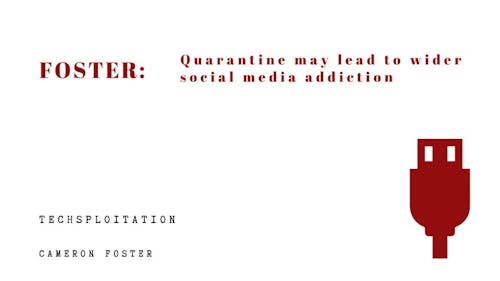FOSTER: Quarantine may lead to wider social media addiction

As we are pushed indoors by a global pandemic, we are more vulnerable to exploitation on behalf of the platforms we are turning to in order to keep ourselves sane.
A report on social media usage during the coronavirus disease (COVID-19) pandemic was published this month by Obviously, an influencer marketing agency. It noted a 76 percent increase in daily accumulated likes on their influencers’ #ad posts within the first two weeks of March 2020 and a 27 percent increase in TikTok engagement. An analysis from The New York Times also noted a significant increase in internet usage from January to March. Desktop web traffic increased by 27 percent on Facebook and 15.3 percent on YouTube.
One Rutgers student said that since going into quarantine, she spends an average of 5 hours a day on TikTok, calling it a never-ending hole of content.
Although social isolation has transformed much of our daily lives in a multitude of ways, this situation fits into a greater trend. In 2019, 45 percent of people worldwide who use social media spent an average of approximately 2.5 hours a day on it, which is an hour more than the average for 2012. That is a 62.5 percent increase over seven years.
Social media addiction is a term that has become familiar over the past few years, with studies linking increased social media usage to negative consequences on users’ mental health and development of coping strategies.
But, addiction to these platforms is often wrongly framed as an individual issue, à la "kids these days with their Snapchats and Instagrams." There is an implication that the blame lies on us for allowing ourselves to become addicted in the first place and, subsequently, that the onus is on the users of these platforms for fixing the problem.
Quite to the contrary, many of the social media platforms people use daily and are spending even more time on now while stuck inside are built to encourage addiction. They are designed to capture and hold the attention of their users, even to the detriment of their health.
To start, social media platforms are designed to alter the way their users’ brains work in the same way that gambling does. In addition to increased symptoms of depression and anxiety, both gambling and internet addictions lead to a lack of impulse control.
This is intentional on the part of the people designing these apps. “There are whole departments trying to design their systems to be as addictive as possible. They want you to be permanently online and, by bombarding you with messages and stimuli, try to redirect your attention back to their app or webpage,” said human behavior expert Daniel Kruger
The pull-to-refresh feature present on social media platforms such as Instagram and Twitter create systems of triggers and rewards in the same way that slot machines do. Each refresh sends a hit of dopamine to the brain, creating a continual feedback loop that keeps people coming back for more.
Snapchat streaks that turn connectivity and communication into a game that can be won prioritize engagement mechanisms over user enjoyment, manufacturing constant dissatisfaction in order to make sure Snapchat users never go a day without opening the app. Infinite scroll has been referred to as “behavioral cocaine” by the very person who described it, who says that “there are generally like literally a thousand engineers that have worked on this thing to try to make it maximally addicting.”
The fact that these features encourage harmful dependencies is not a coincidence. They are doing exactly what they have been built to do. The reason for this is quite simple: It is profitable for these platforms to be addictive.
One former Facebook employee responsible for designing the now-iconic “like” feature acknowledges that many of the tools used by Facebook (and other platforms like Instagram, Twitter and now TikTok) are intentionally habit-forming.
This is because it is one of the main tools used to gather user data. The more scrolling and liking people do, the larger these data sets grow and the more profitable they become to platforms looking to sell it to advertisers and other third parties, something I spoke about in my last article.
Even during a pandemic, advertisers such as Amazon Prime, HBO and even Southwest Airlines are ramping up advertising on platforms like Instagram, Twitter and YouTube, leading to a 25 percent overall increase in digital platform ad spending during the first half of March.
Companies across all industries are busy hashing out new COVID-19-friendly social media marketing strategies as the virus’ death toll continues to rise. As people move onto platforms to fulfill their need for connection and entertainment while quarantined, the data their engagement generates helps make targeted ads more effective, which in turn creates feedback loops between increased browsing, increased spending and increased surveillance imposed by social media companies.
Meanwhile, these very same sites are becoming hotspots of misinformation about the virus, used to spread stereotypes, fear and lies.
There has been plenty said about the power of connectedness granted to us by social media. Indeed, isolation would be a lot more difficult if we suddenly were not able to access the people, communities and resources we depend on to keep us whole.
Even so, it is important to be mindful of the fact that the habits developed during the current lockdown may be all the more difficult to kick even once it is over.
Cameron Foster is a School of Arts and Sciences senior majoring in journalism and media studies. Their column, "Techsploitation," runs on alternate Tuesdays.
*Columns, cartoons and letters do not necessarily reflect the views of the Targum Publishing Company or its staff.
YOUR VOICE | The Daily Targum welcomes submissions from all readers. Due to space limitations in our print newspaper, letters to the editor must not exceed 900 words. Guest columns and commentaries must be between 700 and 900 words. All authors must include their name, phone number, class year and college affiliation or department to be considered for publication. Please submit via email to [email protected] by 4 p.m. to be considered for the following day’s publication. Columns, cartoons and letters do not necessarily reflect the views of the Targum Publishing Company or its staff.



